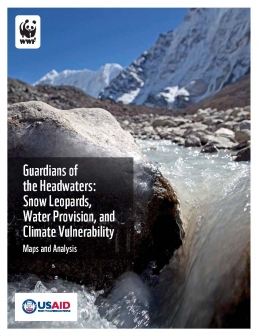Guardians of the Headwaters: Snow Leopards, Water Provision, and Climate Vulnerability: Maps and Analysis
Year:
2014
Publisher:
World Wildlife Fund (WWF) & United States Agency for International Development (USAID)
More than two billion people live in river basins that overlap the snow leopard range, but how important are water sources located in snow leopard habitat to local and downstream human communities? This set of maps is meant to illustrate the key water services provided by snow leopard habitat to human populations, highlighting the most important “ snow leopard headwaters.” We next analyze the vulnerability of these water sources and snow leopard habitat to climate change and other human and natural disturbances. Finally, we consider these results in the context of appropriate management activities to maintain water security and snow leopards through the next millennium.
Snow leopard range is found in 12 countries (Afghanistan, Bhutan, China, India, Kazakhstan, Kyrgyzstan, Mongolia, Nepal, Pakistan, Russia, Tajikistan and Uzbekistan) in northern Asia (spanning the Tibetan Plateau and the Himalayan, Tian Shan and Altai mountain ranges), though the animals are sparsely distributed. Snow leopards prefer rugged and steep terrain, above treeline, but within hunting distance of their favorite prey such as blue sheep, argali, ibex and marmots. Listed as Endangered on the International Union for Conservation of Nature (IUCN) Red List, the greatest current threats to the species are hunting for its pelts, depletion of its natural prey base from hunting (by humans) or competition with livestock, and retaliatory killing by humans for livestock depredation. Anticipated climate change threats include potential changes in grassland communities towards less palatable species for prey and livestock, melting permafrost, increased suitability for cropland and shifting treeline.
Through this book, we present a series of analyses surrounding the water provision services of snow leopard habitat and climate change risk. Each analysis is presented as a map, followed by a description to aid in its interpretation and implications, methods and data used. We summarize the key findings of the effort in the first map, called “Snow Leopard Habitat, Water Provision, and Climate Change.” But all maps and methods leading to the summary map are provided to support the main conclusions, and to aid other scientists and decision makers in developing further interpretations. Note that all analyses are done at a rangewide scale using the best-available data sources. These may mask local-scale patterns that differ from rangewide norms, and are not meant to preclude local-scale studies. Finally, we do not analyze the services of glaciers explicitly in this report because they deserve extensive study of their own, are too detailed to accomplish in this report, and do not form “snow leopard habitat,” per se.
Reference URL:
Work regions:

Files:
